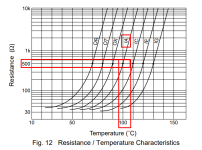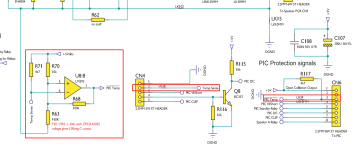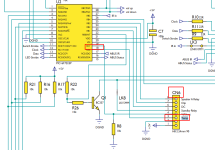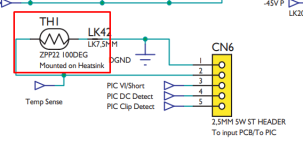Hello everyone
I have a ca azur 640a amplifier
when I switch the power button, the protection diode starts flashing 2 times (overheat), but the amplifier is not even turned on
can it be a problem with programmed PIC on front panel?
I have a ca azur 640a amplifier
when I switch the power button, the protection diode starts flashing 2 times (overheat), but the amplifier is not even turned on
can it be a problem with programmed PIC on front panel?
Well, thats not overheat. Protection means dc on output.
How did you check the output transistors?
How did you check the output transistors?
It's common for the protection circuit to fail on these. I think I found a faulty resistor from memory. Also check output transistor soldering.
If there's no PA fault, that's probably good news--- easier to repair a problem in fault protection circuit than the power amp itself.
On page 18 of manual, look for about 4.7V at D7 to confirm fault protection is active. If so, probe backwards from Q21 to find the path that is generating the fault. There's only four sense points on each channel. It should be relatively straightforward to converge on the issue.
On page 18 of manual, look for about 4.7V at D7 to confirm fault protection is active. If so, probe backwards from Q21 to find the path that is generating the fault. There's only four sense points on each channel. It should be relatively straightforward to converge on the issue.
Attachments
Thank you! Sorry for my error.
So, on page 24 of the manual, do you find about 5V at D18, PIC VI/SHORT ? If so, can you troubleshoot back through Q33 to earlier stages to find the fault path? There appears to be only 4 sense paths on each amp channel.
So, on page 24 of the manual, do you find about 5V at D18, PIC VI/SHORT ? If so, can you troubleshoot back through Q33 to earlier stages to find the fault path? There appears to be only 4 sense paths on each amp channel.
perhaps here some hints
https://www.diyaudio.com/community/threads/cambridge-audio-640a-v2-0-service-manual.309273/
https://www.diyaudio.com/community/threads/cambridge-audio-640a-v2-0-service-manual.309273/
Hello again, thanks for your answers!
So, now my amp can turn on, play music and work normally but after 2-5 minutes protection is triggered and flashing 2 times, i re-soldered all transistors and didn't found any problems with protection circuitry on preamp and amp boards, checked r6/r51, r42, u8 and found nothing unusual, checked +-15 and +5 volts and its ok.
What do I need to do or look at to find the cause of my problem?
So, now my amp can turn on, play music and work normally but after 2-5 minutes protection is triggered and flashing 2 times, i re-soldered all transistors and didn't found any problems with protection circuitry on preamp and amp boards, checked r6/r51, r42, u8 and found nothing unusual, checked +-15 and +5 volts and its ok.
What do I need to do or look at to find the cause of my problem?
Do you have any documentation advising details or clues of "flashing 2 times"?
Coax the amp into the failed state. On page 24, connector CN6 seems to include fault signals--- namely Temp Sense, PIC VI/Short, PIC DC Detect, PIC Clip Detect. Would you measure these voltages?
If PIC VI/Short happens to be about +5V, would you also report voltages across R101 and R102?
Thanks!
Coax the amp into the failed state. On page 24, connector CN6 seems to include fault signals--- namely Temp Sense, PIC VI/Short, PIC DC Detect, PIC Clip Detect. Would you measure these voltages?
If PIC VI/Short happens to be about +5V, would you also report voltages across R101 and R102?
Thanks!
I checked the Service Manual for you for 640A v2.0:
- the thermal protection activates when the PIC gets the info on its leg 18
(if its OK, it should be on 5V, and if overheated, then on GND 0V) - this line comes from connector CN6 pin 3
- and that signal comes from the opamp U8/B forming a voltage comparator
- here the reference threshold voltage comes from the R70/R63 voltage divider and is ~417mV
- and the monitored value comes from the R71/TH1 voltage divider
(the "TH1" is temperature sensor mounted on the heatsink comes from CN4 pin 1-2) - when this R71/TH1 gets above this "417mV" the comparator "fires" and pulls it's output (the "PIC Temp" line) to GND
- this voltage is reached when TH1 gets above ~427 ohm while it gets hot
(and it is below 100 ohm when cold, as the datasheet says for ZPP221A501E as attached)
Attachments
Last edited:
The problem with the double flashing protection LED disappeared after I reconfigured the idling current (on the right channel it was 100 mV, according to the factory it should be 13 mV) and removed a piece of foam rubber that was glued between two vertical protection boards, I cleaned everything from glue and it works!
More than an hour has passed, and the error hasn't shown up again.
However, there's another problem, some crackling and noises in the right channel, how can I diagnose this? Maybe disconnect the audio signal from the preamp?
More than an hour has passed, and the error hasn't shown up again.
However, there's another problem, some crackling and noises in the right channel, how can I diagnose this? Maybe disconnect the audio signal from the preamp?
Good work!
Isolating amp from source is a great way to localize the problem. Volume control to minimum, too.
You might try poking/tapping on components with a wooden chopstick or similar tool. Freeze spray can be “dripped” onto components. Intermittent relay contacts are a surprisingly frequent problem; if you’re find a relay that’s suspicious, you can short across contacts to confirm, but be careful since you’re circumventing a protection mechanism.
Good luck!
Isolating amp from source is a great way to localize the problem. Volume control to minimum, too.
You might try poking/tapping on components with a wooden chopstick or similar tool. Freeze spray can be “dripped” onto components. Intermittent relay contacts are a surprisingly frequent problem; if you’re find a relay that’s suspicious, you can short across contacts to confirm, but be careful since you’re circumventing a protection mechanism.
Good luck!
All relays have already been replaced due to the age of amp with new Relpol RM84-2012-35-1012 (the original was MASSUSE ME-11 012-2Z4) all the specifications in the datasheet are similar.
I found the reason for these sounds in the right channel, if a signal is connected to (let's say AUX), then regardless of the volume there is a crackling sound. What could it be?
Are you saying there's crackling even with volume control at 0?
There has to be signal present to provoke the noise? i.e. just having a RCA cable connected is not sufficient? How large is the signal? Is there a "threshold" level below which the problem abruptly ceases?
Please elaborate with lots of detail.
There has to be signal present to provoke the noise? i.e. just having a RCA cable connected is not sufficient? How large is the signal? Is there a "threshold" level below which the problem abruptly ceases?
Please elaborate with lots of detail.
Yes, there is noise even at zero volume.
In order for it to appear, you only need to connect an RCA cable to any input.
In order for it to appear, you only need to connect an RCA cable to any input.
- Home
- Amplifiers
- Solid State
- Cambridge Audio Azur 640A V2



